Back in 1994, Rare reimagined Donkey Kong, transforming him from his 8-bit arcade origins into a pre-rendered 3D icon. This vision defined the character for nearly three decades, and now Donkey Kong is stepping back into the spotlight with his first original game in over a decade. Bananza isn’t just a return; it’s a reinvention – one of the most imaginative, playful, and technically ambitious titles the company has delivered since Breath of the Wild. From a game design perspective, Bananza pushes the 3D platforming genre into exciting new territory, but from a technical standpoint? It’s a showcase for Nintendo’s latest console.
But let’s not forget: early footage raised some concern. Performance didn’t appear to meet the high standards typically associated with a Nintendo first-party release with plenty of inconsistencies. So, the question is – has this been addressed in the final game? That’s what we’re here to find out – so today we’re diving deep into one of Nintendo’s most fascinating new games in years.
Conceptually, Bananza is a 3D platform game, much like the team’s Mario Odyssey before it, but the formula has been inverted, with players diving deeper into the core of the planet as you progress through all sorts of crazy worlds. What captivated me right away is the weird amalgamation of cuteness and darkness. The game has a unique tone to it that recalls 90s Nintendo, not to mention games like Oddworld – it’s just a bit weird around the edges in a way that made it compelling.
The game makes its most prevalent party trick known right away. During the intro sequence, the camera pans down below the rocky surface revealing a wall and a button prompt – as the wall crumbles, DK emerges, the game elegantly explaining to the player that, yes, you can smash up the environment. It’s the kind of feature players have dreamt about for years – one that games like Red Faction and its Geo-Mod tech first hinted at decades ago. The ability to truly shape the world through destruction: blowing holes in walls, altering terrain, and simulating, to some extent, the laws of physics. But Donkey Kong Bananza takes that concept even further – with an unprecedented volume of destructible surfaces baked directly into the core gameplay. And in many ways, this is what makes the game so fascinating… and, I’d imagine, so challenging to design.
Think about it – Nintendo’s platformers are renowned for their tightly crafted environments, where every platform, hazard and interaction is meticulously tuned. So, the question is: how do you reconcile this with a world that players can smash to pieces? How do you offer freedom without losing the precision and intent behind the level design?
The answer lies in a clever mix of constraints and simulation. Not everything in Bananza is breakable – key structural elements, such as metal, remain intact. This skeletal framework provides the foundation for each level, while allowing the player to wreak havoc on everything else. It’s a delicate balancing act – and it works.
So how does it actually function under the hood? Based on available developer commentary, the team appears to have implemented a voxel-based system for deformable terrain. This allows materials to be carved away in real-time, while layered textures simulate internal structure – dig through a surface and you’ll reveal compacted earth, sediment, or other substrate materials. There’s even a special camera view just for digging, filling in the empty space with a brown fog and drawing only the tunnels – an elegant way to handle potential camera issues. You can clear everything down to bedrock, leaving only the skeleton of the level intact, but your carving efforts aren’t saved if you travel to another world – which is probably for the best.
What’s curious is that the game doesn’t confine its terrain to a boxy voxel structure, suggesting some clever solution. Games like Teardown rely on a hybrid system which uses ray marching and other tricks to create shapes that aren’t strictly defined by the boxy voxel grid, so it’s possible we’re seeing something similar here. There is, however, a trade-off especially compared to something like Teardown: the destruction system does not incorporate full physics simulation. Remove a supporting column, and the ceiling above won’t collapse – it’ll simply float in place. While this might seem like a limitation, it’s a conscious choice that helps keep performance stable while maintaining creative freedom. Full physical simulation, after all, would introduce a massive computational overhead.
Even so, the game embraces this destructibility in playful and inventive ways. You can tunnel beneath terrain, wipe out massive sections of a level, or find alternate paths by brute force. Some enemy attacks will even destroy key platforms, while boss battles creatively leverage the system to dramatic effect. This destruction logic extends to special materials too – like color-coded blocks with unique properties – and even character interactions. When Donkey Kong lands from a height, the ground shatters beneath him, leaving a satisfying crater.
What makes this work even better is how associated animations are used to lend additional weight to each destructive act. Smash a grassy rock and you’ll see blades of grass scatter to the wind as cracks progressively form in the rock with each hit. Another cool feature is how physics driven objects, like spiked balls, are sometimes used to clever effect – carve up the terrain and you can control the flow of these objects. There’s a lot of interesting material interactions like this which combine destruction and physics. What’s truly impressive is how Nintendo managed to preserve handcrafted level design while giving players tools to rip it apart. They’ve created a world where freedom and structure can coexist.
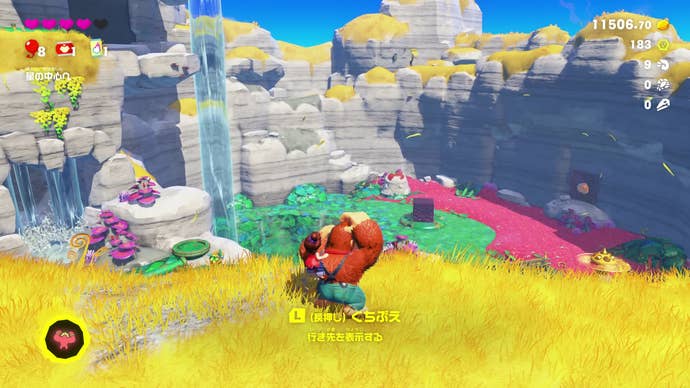
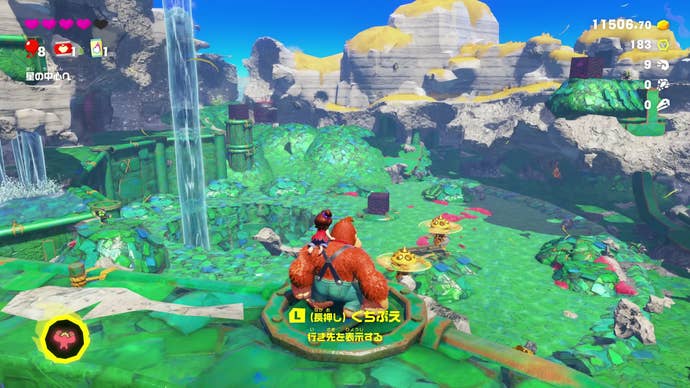
Beyond this, visual fidelity receives a major upgrade over Super Mario Odyssey. Materials and texture detail are a clear step forward, eg in metallic surfaces which have received stunning shader work, with convincing reflections and surface roughness that catch the light beautifully. Character rendering is also top-tier, with sharp, richly animated models and expressive facial work that adds personality to every scene. DK and Pauline stand out in particular – their animation work and emotional range breathe life into the experience in a way few platformers manage.
Plus, the overall environment design, which does explore many traditional platformer themes to be fair, still manages to feel fresh with its subterranean themes – and every location offers surprises. In short, Donkey Kong Bananza doesn’t just offer a compelling gameplay hook – it delivers it through clever technology and a level of polish that once again shows Nintendo at the top of their game.
That doesn’t mean it’s without issue, however…there are still plenty of rough edges that I observed while playing. Pop-in is present throughout when moving towards distant scenery, which is not unexpected, but it can be jarring. The larger issue is that shadow rendering is extremely poor, with sharp saw-tooth edges visible along the low-res shadow maps. You’ll spot a lot of noise anywhere shadows are visible. The SSAO is also somewhat limited and lighting can look dated, something you’ll notice in any indirectly-lit scenes.
This is kind of a bummer in a way. With the Switch 2 updates, games like Mario Odyssey received updates that eliminated many of the visual weaknesses, but here, it feels like we’re dealing with typical Switch-like compromises. Overall, I’d say that Bananza looks really nice overall, but still falls short in a few areas.
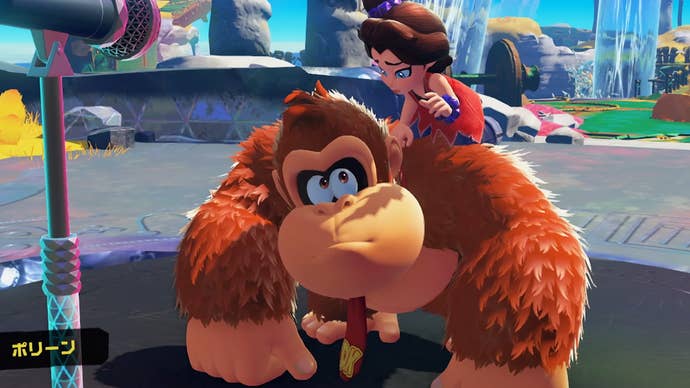
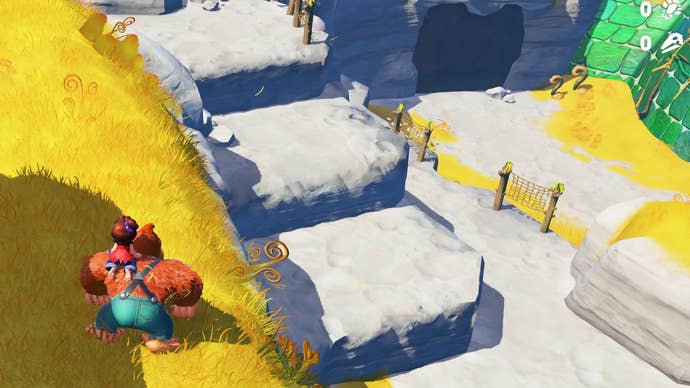
In terms of image quality, I feel Nintendo has been far too conservative, leveraging spatial upscaling technology that’s been with us for years, rather than taking advantage of the new hardware support for DLSS baked into the Switch 2. Instead, Bananza uses a combination of AMD’s FSR1 with SMAA, a post-process anti-aliasing. I admit that image quality is decent, but it’s hard to imagine that the results could have been significantly improved with more modern techniques like DLSS.
The issue is that while edge coverage is OK, in-surface aliasing remains an issue and the overall quality is fairly soft. This isn’t helped by the rather low target resolution, which seems to dynamically range between 1080p and 1200p. In portable form, without direct capture, it’s more difficult to determine, but it does at least produce a convincing 1080p presentation that is very sharp – so image quality is good in handheld, but less so when docked.
Performance is where things actually get really interesting. As we spotted in the DK Direct, there is a lot of slowdown, though the way it manifests is somewhat unusual. Most of the time, frame-rate drops are not sustained – rather, they occur during very specific animations, such as picking up a banana or on certain camera cuts. It’s a bit distracting for sure, but doesn’t impede gameplay too often. However, frame-rate drops also occurred during boss fights, sometimes for sustained periods – and due to the double-buffered v-sync used by the game, this means a very noticeable drop from 60fps to 30fps until the frame-time recovers.
Handheld mode is more interesting. We know that the Switch 2 screen supports VRR, but support for it has been rare outside of the Welcome Tour demos. In fact, no shipping games seem to support VRR under 40fps, so low frame-rate compensation (LFC) isn’t working. That’s still the case with Donkey Kong, where using photo mode reveals the frame-rate can crash down to 30fps. We can’t yet accurately measure this with our tools, but it’s concerning that a first-party title is having the same VRR issues as Hitman. Regardless, from an image quality and performance perspective, Donkey Kong Bananza runs well enough in docked mode and a bit better in portable mode, though it could be improved in both departments.
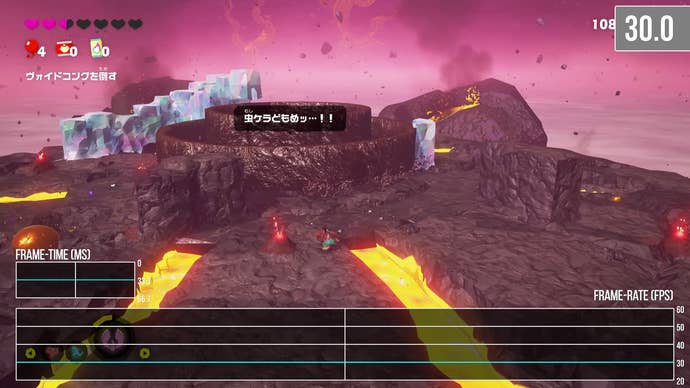
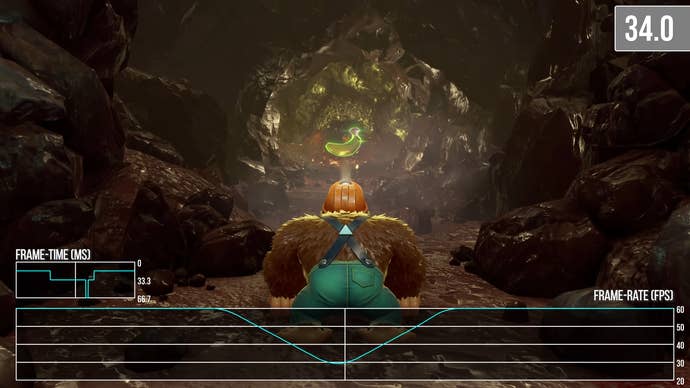
Thankfully, in terms of audio, Bananza is an unmitigated success, matching the lofty ambitions for any mainline Donkey Kong title with catchy, atmospheric tracks that feel well-matched to every scene. The game also supports proper 5.1 surround sound, which was a rarity on the original Switch.
It’s also worth discussing the gameplay itself. As a 3D platform game fan, I was eager to jump into this one and I was not disappointed. In many ways, this feels like a unique hybrid between an internal Nintendo project and something you might have seen from Rare back in the day. The Mario Odyssey lineage is clear, but the level design has its own unique feel, thanks to DK’s capabilities. I loved Mario Odyssey, but parts of the game always felt a little sedate. DK’s pacing is faster overall and it feels like the game throws more unique ideas at you per minute. There’s also a level of freedom in how you solve problems that I found refreshing – this isn’t quite Breath of the Wild in that sense, but it is less rigid than most 3D platformers out there. That makes it feel really unique.
The solid controls, creative challenges and excellent presentation all left a strong impression on me and I definitely think Bananza is one of Nintendo’s best platform games in a long while – at least in terms of 3D platforming. It’s a great way to kick off the Switch 2 generation and comes highly recommended. Technically, it has a few lingering issues, but what the team has accomplished here is still quite impressive.



